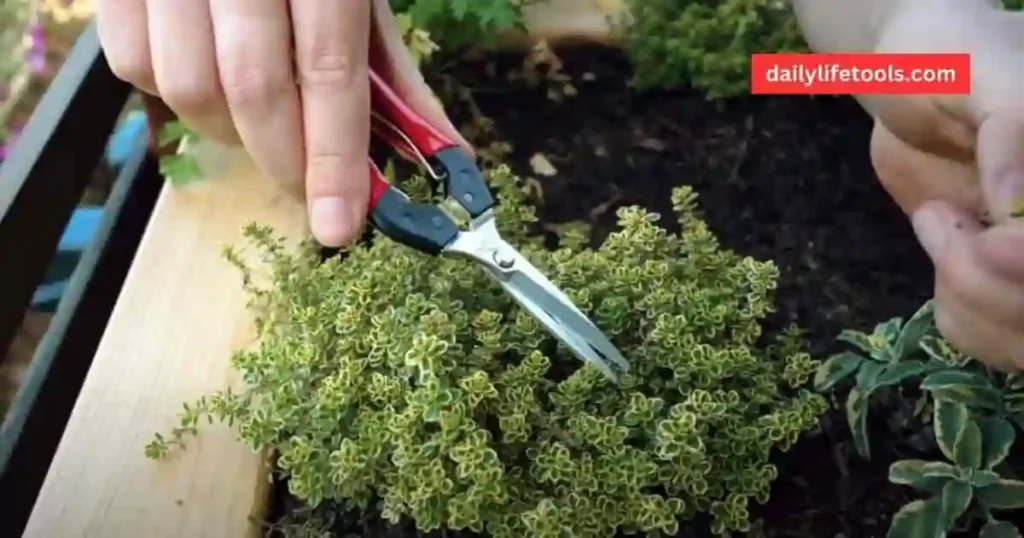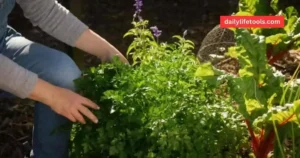In this guide, we’ll delve into everything you need to know about thyme, from growing tips and watering advice to its health benefits and creative uses.
Whether you’re a newbie or a seasoned gardener, you’ll find practical insights and fun ideas to make the most of this aromatic herb.
Hey there, dear gardeners! I’m Hasan, and I’ve been gardening for about 8 years.
Table of Contents
Thyme
Thyme is a lovely aromatic herb, known for its flavor, fragrance, and ornamental beauty.
It’s part of the mint family, along with basil, oregano, rosemary, and lavender.
Thyme loves full sun and well-drained soil, and it can be a beautiful addition to garden beds and containers.
How to Grow Thyme
Hey there, Alabama gardeners! If you’re just starting out or have a few seasons under your belt, growing this aromatic herb can be a rewarding experience.
So, let’s dive into the different ways you can Grow thyme, whether you’re looking to expand your garden or share some thyme love with family.
1. Seed Propagation
Starting thyme from seed is like nurturing a baby it takes time and patience, but the rewards are worth it.
- Start Indoors: If you’re in Alabama, start your seeds indoors about 6-10 weeks before the last frost. I usually plant mine in early February.
- Sow Lightly: Thyme seeds are tiny, so sprinkle them on top of the soil and gently press them down. No need to bury them; they like to stay close to the surface.
- Water Gently: Mist the soil to keep it moist but not drenched. Cover the tray with plastic wrap to keep humidity in. Within 2-4 weeks, you’ll start seeing tiny sprouts.
Once the seedlings are sturdy enough, you can transplant them into your garden, spacing them about 12-18 inches apart. Remember, thyme likes a little elbow room to grow.
2. Cutting Propagation

If you’ve got an established thyme plant, propagating by cuttings is a quick and easy way to get more plants.
- Pick Your Stems: Choose a healthy, non-flowering stem that’s about 3-4 inches long. This is usually where I like to get a bit selective picking the best-looking stems makes me feel like a garden artist.
- Prepare the Cuttings: Remove the leaves from the bottom half of the cutting and stick the bare stem into a pot of moist, well-draining soil. Cover it with a plastic bag to keep humidity high.
- Wait for Roots: In about 4-6 weeks, you should see new roots forming. Then, you’re ready to transplant the new plant into your garden or a larger pot.
3. Layering Propagation
Layering is a natural method, perfect if you’ve got a thyme plant that’s already spreading out a bit.
- Find a Low Stem: Pick a low-growing stem that can easily touch the soil. Bend it down and cover a section of it with soil, leaving the growing tip exposed.
- Pin It Down: Secure the stem with a small stake or pin to keep it in contact with the soil.
- Let It Root: After a few weeks, the covered section will start to grow roots. Once it’s rooted, cut the new plant from the parent and transplant it.
4. Division Propagation
If your thyme plant has been around for a while, dividing it is a great way to give it new life.
- Dig It Up: In early spring or fall, dig up the entire thyme plant.
- Divide and Conquer: Use a sharp knife to divide the root ball into smaller sections. Each section should have its own roots and stems.
- Replant: Plant the divisions in their new spots, spacing them out so they have room to grow.
Tips for Success:
- Timing: Spring and early summer are ideal for propagation, as thyme is actively growing.
- Watering: Keep the soil moist during the rooting phase, but avoid waterlogging.
- Light: Thyme prefers bright, indirect light during propagation.
- Temperature: Aim for a temperature of 60-70°F (15-21°C) for optimal growth during propagation.
Propagating thyme is like adding more flavor to your garden. Whether you’re starting from seed, cuttings, layering, or division, each method has its own charm.
I’ve tried them all over the years, and there’s nothing quite like watching a tiny cutting grow into a full-fledged plant.
Watering Tips for Thyme
I’ve learned a lot about keeping thyme happy, especially in our warm, southern climate.
Here’s the scoop on how to keep this herb thriving without drowning it.
1. Water Less, Not More
Thyme is a bit of a dry-thirsty plant. Overwatering can lead to problems faster than you can say “herb garden.” Aim to water only when the soil is completely dry.
In the summer heat, this might mean every 10-15 days. Trust me, less is more with thyme.
2. Morning Is Best
Water your thyme in the morning. This helps the plant soak up the moisture before the sun turns up the heat.
Plus, it keeps the soil from becoming a breeding ground for mold or mildew.
I’ve learned that starting the day with a splash of water (and coffee) is a winning combo.
3. Deep and Slow
When you do water, give your thyme a good, deep soak. This encourages roots to dig deep and helps the plant withstand those sizzling Alabama summers.
A light sprinkle won’t do much; it’s like giving a drink to a fish in a dry pond.
4. Keep the Leaves Dry
Try to water the soil and not the leaves. Wet leaves can lead to fungal issues, which thyme isn’t too fond of.
Thyme loves the shade and avoids getting wet. Aim the hose or watering can at the base of the plant.
5. Use Mulch Wisely
A layer of mulch around your thyme can be a lifesaver. It helps keep the soil moist and prevents those pesky weeds from stealing water.
Mulch acts like a cozy blanket for your plants, keeping them warm and hydrated during dry spells.
6. Pot Care
If your thyme is in a pot, make sure it has good drainage. Water until you see it running out of the bottom, then let it dry out before the next watering.
Think of it like a coffee filter; you want to avoid a soggy mess.
7. Adjust for Rainfall
Check the forecast before watering. If it’s been raining, skip the watering session. Thyme doesn’t want to sit in puddles; it prefers to dry out between drinks.
A little attention to the weather can save your plant from a soggy fate.
So, there you have it my tried-and-true tips for keeping your thyme happy and healthy.
Growing Tips & Facts
- Soil: Slightly alkaline, well-drained soil with a pH above 7.0. Add lime if needed.
- Varieties: German thyme is aromatic and great for cooking, while lemon thyme has a citrusy flavor.
Tips for Using & Storing
- Harvest: Clip stems as needed. Use leaves in soups, stews, and sauces.
- Preserve: Dry, freeze, or preserve in oil/butter.
Thyme Health Benefits
Thyme is not just flavorful; it’s packed with health benefits.
1. Reduces cholesterol
2. Fights infections
3. Rich in vitamins and minerals
4. Reduces stress
5. Protects from cancer
6. Treats skin infections and wounds
7. Supports digestive health
8. Fights colds and flu
9. Good for general health and skin health
Thyme Companion Planting
Knowing what plants grow well with thyme can enhance your garden.
Best Companions
- Vegetables: Tomatoes, cabbage, potatoes
- Herbs: Rosemary, oregano, sage
- Berries & Flowers: Strawberries, blueberries, roses
Uses
Thyme is incredibly versatile.
- Household: Potpourri, bee-friendly, household disinfectant
- Medicinal: Boosts circulation, aids digestion, relieves sore throats and headaches
- Culinary: Great in tea, stuffings, stocks, sauces, soups, poultry, shellfish, and more.
Thyme Tea
Thyme tea can be used as a mouthwash, gargle, or foot soak. Add honey for colds, lemon for sore throats, mint for coughs, or ginger for nausea.
Ingredients
- 1 teaspoon dried thyme
- 1 cup boiling water
Directions
Steep thyme in boiling water for 15 minutes, then strain.
Thyme Nutritional Profile
100 grams of dried thyme contains:
- Water: 7.79 g
- Energy: 276 kcal
- Protein: 9.11 g
- Fat: 7.43 g
- Ash: 11.7 g
- Carbohydrates: 63.9 g
- Fiber: 37 g
Conclusion
In summary, thyme offers a wealth of benefits, from its versatile uses in the kitchen to its impressive health perks.
By understanding how to grow, water, and care for this aromatic herb, you can enjoy its flavor and fragrance year-round.
With the right tips for using and storing thyme, plus insights into its nutritional profile and companion planting, you’ll be well-equipped to make the most of this herb.






